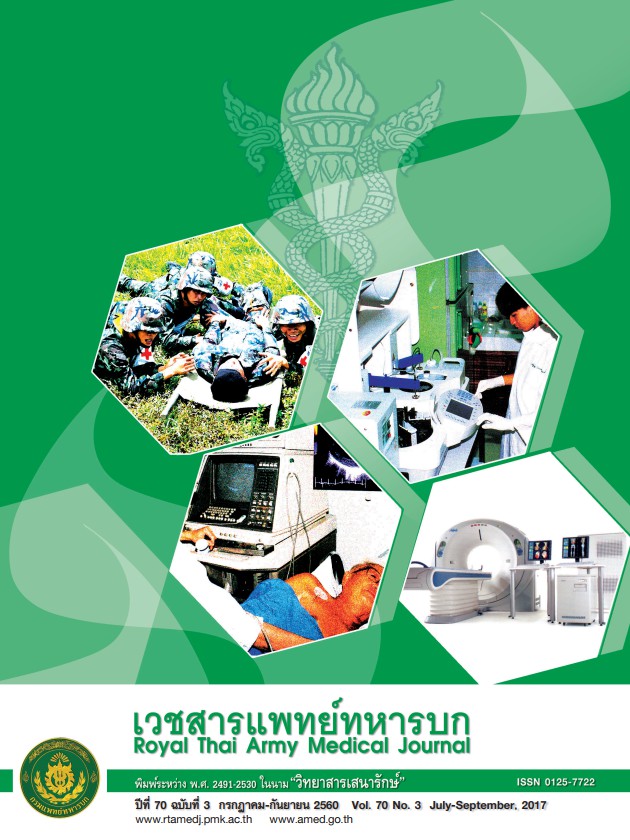การเปรียบเทียบการรบกวนความคมชัดจากการเคลื่อนไหวของภาพระยะอาร์เทอเรียล ขณะตรวจตับด้วยเครื่องตรวจอวัยวะด้วยคลื่นสนามแม่เหล็กไฟฟ้า
Main Article Content
บทคัดย่อ
วัตถุประสงค์ เพื่อเปรียบเทียบการรบกวนความคมชัดของภาพจากการเคลื่อนไหวหลังได้รับสารเพิ่มความชัดระหว่างกลุ่มผู้ป่วยที่ได้รับ Gadoxetate disodium และ Gadobutrol ขณะตรวจตับด้วยเครื่อง MRI วัสดุและวิธีการ ศึกษาวิจัยเชิงวิเคราะห์โดยเก็บข้อมูลไปข้างหน้า ในผู้ป่วยที่มาตรวจรอยโรคของตับ ด้วยเครื่อง MRI ในห้วงพฤษภาคม 2557 ถึง มกราคม 2558 จำนวน 268 ราย โดยแบ่งเป็นกลุ่มผู้ป่วยที่ได้รับสารเพิ่มความชัดชนิด Gadoxetate disodium 128 ราย และ Gadobutrol 140 ราย ชุดภาพการตรวจ MRI ทั้งหมดในระยะก่อนฉีดสารเพิ่มความชัด หลังฉีดสารเพิ่มความชัดระยะอาร์เทอเรียลและหลังฉีดสารเพิ่มความชัดระยะพอร์ทัลจะถูกแปลผลเรื่องการรบกวนความคมชัดของภาพจากการเคลื่อนไหว (motion artifact) โดยรังสีแพทย์ 2 ท่าน แล้วนำผลมาวิเคราะห์ทางสถิติเพื่อเปรียบเทียบการรบกวนความคมชัดของภาพจากการเคลื่อนไหว ระหว่างผู้ที่ได้รับทั้ง 2 กลุ่ม ผลการศึกษา พบว่ากลุ่มที่ได่รับ Gadoxetate disodium มีการรบกวนคุณภาพของภาพจากการเคลื่อนไหว ในระยะอาร์เทอเรียลมากกว่ากลุ่มที่ได้รับ Gadobutrol อย่างมีนัยสำคัญทางสถิติ (18 of 128 vs 2 of 140, p-value < 0.001) โดยใช้สถิติ logistic regression ส่วนชุดภาพในระยะก่อนฉีดสารเพิ่มความชัดและชุดภาพหลังฉีดสารเพิ่มความชัดระยะพอร์ทัล ไม่พบว่ามีการรบกวนคุณภาพของภาพจากการเคลื่อนไหวที่แตกต่างกันอย่างมีนัยสำคัญทางสถิติ สรุป การฉีดสารเพิ่มความชัดชนิด Gadoxetate disodium ส่งผลให้เกิดการรบกวนความคมชัดภาพจากการเคลื่อนไหว ของภาพ MRI ในระยะอาร์เทอเรียล มากกว่าการฉีด Gadobutrol ซึ่งส่งผลต่อการวินิจฉัยโรค ทำให้ผู้ป่วยบางรายต้องมาตรวจซ้ำ
Comparison Motion Artifact on Arterial Phase Image of Liver MRI Study After Intravenous Administration of Gadoxetate Disodium and Gadobutrol in Phramongkutklao Hospital
Objective: To determine respiratory motion artifact on arterial phase image of liver MRI study after intravenous administration of Gadoxetate disodium and Gadobutrol.Materials and Methods: A prospective observational study was conducted among patients who underwent liver MRI study with intravenous administration of Gadoxetate disodium and Gadobutrol; during the period between May 2014 and January 2015. There were a
total 268 patients, who are 140 patients Gadobutrol administration and 128 patients Gadoxetate disodium administration. Motion artifact on T1-weighted precontrast and dynamic postcontrast (arterial and venous phase) magnetic resonance imaging (MRI) dataset were independently assessed in randomized, binded fashion by two readers using a five-point scale, with mean scores of 4 and 5 indicating severe respiratory motion artifact. The comparisons motion artifact between two contrast media agents were calculated by using a logistic regression test.Results: Significantly more severe motion artifact of arterial phase image of liver MRI study after Gadoxetate disodium administration than Gadobutrol administration [14.1% (18 of 128) vs 1.4% (2 of 140), p < 0.001]. No difference of severe motion artifact in precontrast and venous phase imaging. There was no other factor difference between two agents. Conclusion: Intravenous administration of Gadoxetate disodium can result in
severe motion artifact on arterial phase image of liver MRI study than Gadobutrol which effect on making the accurate diagnosis and the necessary to repeat MRI study.
Downloads
Article Details
บทความในวารสารนี้อยู่ภายใต้ลิขสิทธิ์ของ กรมแพทย์ทหารบก และเผยแพร่ภายใต้สัญญาอนุญาต Creative Commons Attribution-NonCommercial-NoDerivatives 4.0 International (CC BY-NC-ND 4.0)
ท่านสามารถอ่านและใช้งานเพื่อวัตถุประสงค์ทางการศึกษา และทางวิชาการ เช่น การสอน การวิจัย หรือการอ้างอิง โดยต้องให้เครดิตอย่างเหมาะสมแก่ผู้เขียนและวารสาร
ห้ามใช้หรือแก้ไขบทความโดยไม่ได้รับอนุญาต
ข้อความที่ปรากฏในบทความเป็นความคิดเห็นของผู้เขียนเท่านั้น
ผู้เขียนเป็นผู้รับผิดชอบต่อเนื้อหาและความถูกต้องของบทความของตนอย่างเต็มที่
การนำบทความไปเผยแพร่ซ้ำในรูปแบบสาธารณะอื่นใด ต้องได้รับอนุญาตจากวารสาร


